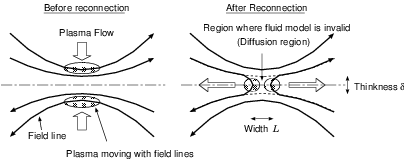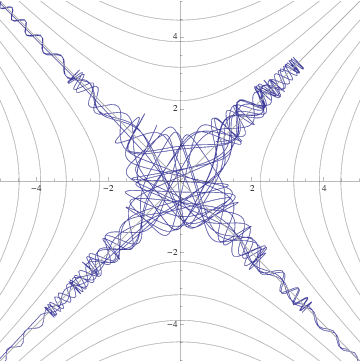Magnetic Reconnection
Overview
Magnetic reconnection is a commonly observed fundamental process where field lines change their topology, and the magnetic energy is explosively released and converted to the plasma energy.
According to the magnetohydrodynamics (MHD) equations which describe macroscopic behavior of plasmas, field lines move together with plasmas (frozen-in to plasmas), and do not reconnect. Consider plasma dynamics under an anti-parallel magnetic field configuration given in the left figure below. When plasmas flow to compress field lines, plasmas will be pushed back by the magnetic pressure as long as field lines do not break. However, if field lines break and reconnect due to some mechanism (see the right figure below), the reconnected field lines try to shrink due to the magnetic tension force like a rubber band. Plasmas are carried away with the reconnected field lines. At the reconnection point, plasma pressure decreases, thus further plasma flows will be induced to carry another field lines, and reconnection continues spontaneously. This series of process is called magnetic reconnection. The initial magnetic field configuration stores high magnetic energy, which is released via magnetic reonnction, and is converted into the kinetic or thermal energies of plasmas.

Magnetic reconnection is thought to be responsible for eruptive events of the solar surface, such as solar flares, coronal mass ejections, or coronal plasma heating, acceleration of non-thermal high-energy particles. In fusion plasmas, magnetic reconnection degrades plasma confinement by breaking magnetic surface structures.
Microscopic particle behaviors which can not be described by fluid models play important roles for magnetic reconnection to occur. The primary mechanism of field-line breaking is resistivity due to inter-particle collisions (diffusion of magnetic fields). However, since the collision effect is weak in high-temperature, rarefied plasmas, other microscopic effects (called kinetic effects) must be taken into account. Difficulty of the magnetic reconnection study lies in self-consistently treating hugely separated scale processes between macroscopic magnetic reconnection phenomena (having scale on the solar surface) and microscopic particle process (about a few scale).
Collisionless dissipation mechanism due to chaotic motion of particles
In the recent studies, it is pointed out that the two-fluid effect caused by difference between ion and electron motions (the Hall effect) plays crucial roles for explosive magnetic reconnection (fast magnetic reconnection). The two-fluid plasma model has an intrisic spatial scale called the ion skin depth. IN the microscopic region of magnetic reconnection, magnetic field structure is strongly inhomogeneous, and changes in the ion skin depth scale where ion motion can be chaotic. In a chaotic system where unpredictable dynamics occurs, particle behaviors are completely different with slightly different initial conditions, and collective behavior of those particles may yield entropy production mechanism.
The figure below shows particle motion in the magnetic field configuration similar to magnetic reconnection. The black hyperbolic lines show magnetic field lines. Near the origin where the magnetic field is weak and the conservation of magnetic moment breaks down, particle motion becomes chaotic. Because of this chaotic particle motion, current is generated ine response to the reconnection electric field (perpendicular to the plane). (If particles are magnetized, particles only drift and no parallel current can be generated.) The effective resistivity is defined by the ratio of the electric field and the generated current. This chaos induced resistivity does not depend on plasma temperature, thus can be greater compared with the collisional one in high-temperature plasmas.

To apply the chaos induced collisionless resistivity to magnetic reconnection, we introduced a mesoscopic region where multiply chaos regions exist in the Petschek model (a global magnetic reconnection model based on MHD with shocks), and constructed a self-consistent magnetic reconnection model.
Gyrokinetic simulation of magnetic reconnection